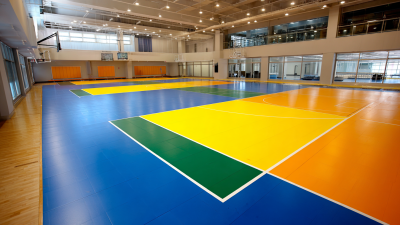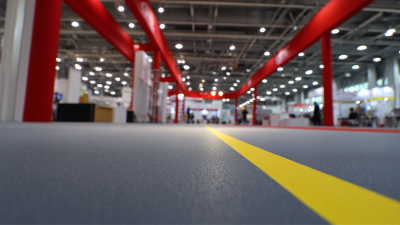
-
Home
-
About Us
-
Products
-
Solution
-
Accessories Service
-
Technicial Service
-
Additional Service
-
News
-
Blog
-
Contact Us
Leave Your Message

When creating an effective fitness space, the choice of
Gym Floor Mats
is often overlooked, yet it plays a crucial role in both safety and functionality.
According to a report from the International Health, Racquet & Sportsclub Association (IHRSA), nearly
40%
of gym injuries can be attributed to improper flooring surfaces. This statistic highlights the importance
of selecting the right mats to provide a secure and slip-resistant environment for athletes and fitness
enthusiasts alike.
Expert in fitness facility design, Dr. Mark
Thompson emphasizes the significance of high-quality Gym Floor Mats, stating, "The right flooring not only
enhances performance but also significantly reduces the risk of injury." With various materials and
thickness options available, choosing the right Gym Floor Mats can increase comfort during workouts,
improve shock absorption, and enhance stability during dynamic movements. As we delve deeper into the
essential factors to consider, it becomes clear that investing in the right flooring is vital for a
successful and safe fitness space.

When setting up a fitness space, the choice of gym floor mats is crucial for both functionality and safety. Understanding the importance of gym floor mats goes beyond just aesthetics; these mats provide essential cushioning and stability for exercises, preventing slips and injuries during workouts. Mats made from high-quality materials like EVA foam are especially beneficial, as they offer a soft yet stable surface for floor-based exercises, stretching, and yoga sessions.
**Tips:** When selecting gym floor mats, consider the types of activities you’ll be doing. For high-impact exercises, opt for thicker mats that can absorb shock effectively. Additionally, look for mats with good grip to ensure stability during dynamic movements. Don't forget to assess the maintenance aspect; mats that are easy to clean can help maintain hygiene in your workout space.
Creating an inviting and safe personal gym environment encourages you to engage in regular exercise. The right flooring can enhance the overall experience and protect your floors from damage. Investing in quality gym mats is a step toward achieving your fitness goals and making your workout routine enjoyable and efficient.
| Mats Type | Material | Thickness (inches) | Water Resistance | Price Range (USD) |
|---|---|---|---|---|
| Interlocking Foam Mats | EVA Foam | 0.5 - 1.0 | Yes | $40 - $100 |
| Rubber Gym Mats | Recycled Rubber | 3/8 - 1/2 | Yes | $50 - $200 |
| Vinyl Flooring Mats | Vinyl | 1/8 - 1/4 | Yes | $70 - $250 |
| CARPET Gym Mats | Polypropylene | 1/4 - 1/2 | No | $30 - $150 |
| Turf Mats | Synthetic Grass | 1/2 - 1 | Yes | $100 - $300 |
When selecting gym floor mats, it's essential to focus on key features that ensure safety, durability, and functionality. One critical aspect to consider is the material. High-quality mats are typically made from heavy-duty rubber or PVC, offering superior grip and shock absorption. According to a report from the International Health, Racquet & Sportsclub Association (IHRSA), over 60% of gym injuries are due to slips and falls, emphasizing the importance of a non-slip surface.
Additionally, consider the thickness of the mats. For general fitness areas, ¼ inch thick mats are often sufficient, while areas designated for heavy weight training may require mats up to 1 inch thick to effectively absorb impact and reduce noise. The American Council on Exercise (ACE) recommends mats that are easy to clean and maintain, as hygiene is vital in fitness spaces.
Tip: When shopping for gym mats, look for those with a textured surface to enhance grip and prevent accidental slips during workouts.
Another factor is the size and interlocking capability of the mats. Larger pieces can cover more ground and reduce seams, while interlocking mats allow for customization based on the specific layout of your gym space. A report from Mintel indicates that the fitness equipment market, including mats, is anticipated to reach $14 billion by 2025, making it crucial to invest in high-quality options that meet your specific needs.
Tip: Always check for warranties or guarantee periods offered by manufacturers, which can indicate the durability and quality of the mats.
When selecting gym floor mats, understanding the different materials available is crucial to finding the best fit for your fitness space. Foam mats are an excellent choice for areas dedicated to high-impact activities, such as yoga or pilates. Their cushioning properties help absorb shock and provide comfort, making them ideal for floor exercises. They are lightweight and easy to install, but it’s essential to note that they may not be as durable as other options, especially in high-traffic areas.
Rubber mats, on the other hand, are favored for their durability and strength, making them suitable for weightlifting areas or spaces with heavy equipment. They offer excellent traction and resistance to wear and tear, ensuring a safe workout environment. Additionally, rubber mats are often water-resistant and easy to clean, which is a considerable advantage in maintaining hygiene. Ultimately, the material you choose should align with the activities you plan to perform and the level of durability you require for your specific needs.
When selecting gym floor mats for your fitness space, it's essential to prioritize both performance and durability. In 2025, several options stand out as the top choices that cater to a variety of workout environments.
 The first on the list is the ProForm Fitness Mat, renowned for its exceptional grip and shock absorption, making it perfect for high-intensity workouts. Its resilient material ensures it withstands heavy use, giving you peace of mind during your training sessions.
The first on the list is the ProForm Fitness Mat, renowned for its exceptional grip and shock absorption, making it perfect for high-intensity workouts. Its resilient material ensures it withstands heavy use, giving you peace of mind during your training sessions.
Another noteworthy contender is the BalanceFrom GoGym Mat, which combines portability with cushioning. This mat is ideal for yoga and Pilates enthusiasts, providing a non-slip surface that enhances stability and comfort. For those focused on powerlifting, the Titan Fitness Rubber Mat is a top recommendation, offering superior durability while protecting your floors from heavy weights. Each of these mats is designed not just to perform well but to provide a lasting investment for anyone serious about their fitness journey.
When it comes to maintaining your gym floor mats, regular care is crucial for extending their lifespan and ensuring a safe workout environment. According to a report by IBISWorld, the fitness floor mat industry is projected to grow by 4% annually as more individuals prioritize exercise spaces at home and in commercial gyms. This growth underscores the importance of selecting high-quality mats and instituting effective maintenance practices. Regularly cleaning mats with a mild detergent and water can prevent the buildup of dirt and bacteria, which not only prolongs the mats' integrity but also promotes hygiene for users.

In addition to routine cleaning, it's essential to implement preventative measures to protect your gym mats from wear and tear. A study by the American Sports Medicine Institute suggests that mats are most susceptible to damage from heavy equipment and improper footwear. Using rubberized mats in high-traffic areas and placing protective covers during high-intensity workouts can significantly reduce the risk of premature damage. Furthermore, rotating mats periodically can help distribute wear evenly, thereby enhancing their durability and performance. By following these maintenance tips, gym owners and fitness enthusiasts can ensure their mats remain functional and visually appealing for years to come.





